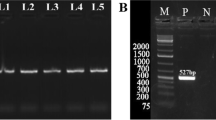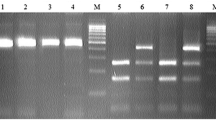Abstract
Seven pairs of primers were designed to amplify 5′ promoter region, six exons and partial introns and to detect the polymorphisms of POU1F1 gene in five goat breeds with different prolificacy. The results showed that six mutations were identified in caprine POU1F1 gene including C256T in exon 3, C53T and T123G in intron 3, and G682T (A228S), T723G and C837T in exon 6. The former four mutations were novel SNPs in goat POU1F1 gene. The 53 and 123 loci were in complete linkage disequilibrium in five caprine breeds. Regarding the 256 locus, the Jining Grey goat does with genotype CT had 0.66 kids more than those with genotype CC (P < 0.05), while does with genotype GT had 0.63 (P < 0.05) kids more than those with genotype GG at the 682 locus. The present study preliminarily showed an association between allele T at the 256 and 682 loci of POU1F1 gene and high litter size in Jining Grey goats. Totally 16 haplotypes and 50 genotypes were identified at the above six loci in POU1F1 gene of five goat breeds. Three common haplotypes (hap2, hap3 and hap4) were identified in five goat breeds joined. Four specific haplotypes (hap7, hap9, hap11 and hap13) were detected in Jining Grey goats. The predominant haplotype was hap1 (35.29% and 48.25%) in both Jining Grey and Guizhou White goats, while hap4 (50%) in Boer goats, and hap2 (42.86% and 38.75%) in both Wendeng Dairy and Liaoning Cashmere goats. The most frequent genotypes at six loci in the above five goat breeds were hap1/hap2 (14.38%) and hap1/hap4 (14.38%), hap1/hap2 (38.60%), hap4/hap4 (40.91%), hap2/hap4 (26.53%), hap2/hap5 (20.00%), respectively. The Jining Grey goat does with nine genotypes analyzed of POU1F1 gene showed no obvious difference in litter size.




Similar content being viewed by others
References
Woollard J, Tuggle CK, Ponce de León FA (2000) Localization of POU1F1 to bovine, ovine, and caprine 1q21–22. J Anim Sci 78(1):242–243
Li S, Crenshaw EB, Rawson EJ, Simmons DM, Swanson LW, Rosenfeld MG (1990) Dwarf locus mutants lacking three pituitary cell types result from mutations in the POU-domain gene pit-1. Nature 347(6293):528–533
Simmons DM, Voss JW, Ingraham HA, Holloway JM, Broide RS, Rosenfeld MG, Swanson LW (1990) Pituitary cell phenotypes involve cell-specific Pit-1 mRNA translation and synergistic interactions with other classes of transcription factors. Genes Dev 4(5):695–711
Nelson C, Albert VR, Elsholtz HP, Lu LI, Rosenfeld MG (1988) Activation of cell-specific expression of rat growth hormone and prolactin genes by a common transcription factor. Science 239(4846):1400–1405
Mullis PE (2007) Genetics of growth hormone deficiency. Endocrinol Metab Clin N Am 36(1):17–36
Ben-Batalla I, Seoane S, Macia M, Garcia-Caballero T, Gonzalez LO, Vizoso F, Perez-Fernandez R (2010) The Pit-1/Pou1f1 transcription factor regulates and correlates with prolactin expression in human breast cell lines and tumors. Endocr Relat Cancer 17(1):73–85
Cohen LE, Wondisford FE, Radovick S (1996) Role of Pit-1 in the gene expression of growth hormone, prolactin, and thyrotropin. Endocrinol Metab Clin N Am 25(3):523–540
Sun HS, Anderson LL, Yu TP, Kim KS, Klindt J, Tuggle CK (2002) Neonatal Meishan pigs show POU1F1 genotype effects on plasma GH and PRL concentration. Anim Reprod Sci 69(3–4):223–237
Svennersten-Sjaunja K, Olsson K (2005) Endocrinology of milk production. Domest Anim Endocrinol 29(2):241–258
Akers RM (2006) Major advances associated with hormone and growth factor regulation of mammary growth and lactation in dairy cows. J Dairy Sci 89(4):1222–1234
Huang W, Maltecca C, Khatib H (2008) A proline-to-histidine mutation in POU1F1 is associated with production traits in dairy cattle. Anim Genet 39(5):554–557
Hull KL, Harvey S (2001) Growth hormone: roles in female reproduction. J Endocrinol 168(1):1–23
Curlewis JD (1992) Seasonal prolactin secretion and its role in seasonal reproduction: a review. Reprod Fertil Dev 4(1):1–23
Chu MX, Wang XC, Jin M, Di R, Chen HQ, Zhu GQ, Fang L, Ma YH, Li K (2009) DNA polymorphism of 5′ flanking region of prolactin gene and its association with litter size in sheep. J Anim Breed Genet 126(1):63–68
Zamiri MJ, Khodaei HR (2005) Seasonal thyroidal activity and reproductive characteristics of Iranian fat-tailed rams. Anim Reprod Sci 88(3–4):245–255
Yasuo S, Yoshimura T, Ebihara S, Korf HW (2010) Photoperiodic control of TSH-beta expression in the mammalian pars tuberalis has different impacts on the induction and suppression of the hypothalamo-hypopysial gonadal axis. J Neuroendocrinol 22(1):43–50
Bastos E, Avila S, Cravador A, Renaville R, Guedes-Pinto H, Castrillo JL (2006) Identification and characterization of four splicing variants of ovine POU1F1 gene. Gene 382:12–19
Lan XY, Pan CY, Chen H, Lei CZ, Hua LS, Yang XB, Qiu GY, Zhang RF, Lun YZ (2007) DdeI polymorphism in coding region of goat POU1F1 gene and its association with production traits. Asian-Australasian Journal of Animal Sciences 20(9):1342–1348
Tu YR (1989) The sheep and goat breeds in China. Shanghai Science and Technology Press, Shanghai, pp 88–90, 98–101, 112–114
Malan SW (2000) The improved Boer goat. Small Rumin Res 36(2):165–170
Tao XP, Wang H, Ju SC, Ni ZL, Diao XJ (2001) Preliminary study on reproductive performance of the Boer goat. China Herbiv 3(5):26–27
Gong ZJ, Hou Wl, Dong YA, Qu GK, Wang JP, Xu GP (2003) The characteristics and management of Wendeng dairy goat. Ecol Domest Anim 24(4):79–80
Lan XY, Pan CY, Chen H, Zhang CL, Li JY, Zhao M, Lei CZ, Zhang AL, Zhang L (2007) An AluI PCR-RFLP detecting a silent allele at the goat POU1F1 locus and its association with production traits. Small Rumin Res 73:8–12
Lan XY, Pan CY, Chen H, Lei CZ (2007) A DdeI PCR-RFLP detecting genetic variation of goat POU1F1 gene. Can J Anim Sci 87(1):13–14
Lan XY, Shu JH, Chen H, Pan CY, Lei CZ, Wang X, Liu SQ, Zhang YB (2009) A PstI polymorphism at 3′UTR of goat POU1F1 gene and its effect on cashmere production. Mol Biol Rep 36(6):1371–1374
Lan XY, Pan CY, Li JY, Guo YW, Hu S, Wang J, Liu YB, Hu SR, Lei CZ, Chen H (2009) Twelve novel SNPs of the goat POU1F1 gene and their associations with cashmere traits. Small Rumin Res 85(2):116–121
Bastos E, Santos I, Parmentier I, Castrillo JL, Cravador A, Guedes-Pinto H, Renaville R (2006) Ovis aries POU1F1 gene: cloning, characterization and polymorphism analysis. Genetica 126(3):303–314
Schaid DJ (2004) Evaluating associations of haplotypes with traits. Genet Epidemiol 27:348–364
Sun Y, Zhang F, Gao J, Gao X, Guo T, Zhang K, Shi Y, Zheng Z, Tang W, Zheng Y, Li S, Li X, Feng G, Shen X, He L (2006) Positive association between POU1F1 and mental retardation in young females in the Chinese Han population. Hum Mol Genet 15:1237–1243
Yu TP, Wang L, Tuggle CK, Rothschild MF (1999) Mapping genes for fatness and growth on pig chromosome 13: a search in the region close to the pig PIT1 gene. J Anim Breed Genet 116:269–280
Hendriks-Stegeman BI, Augustijn KD, Bakker B, Holthuizen P, van der Vliet PC, Jansen M (2001) Combined pituitary hormone deficiency caused by compound heterozygosity for two novel mutations in the POU domain of the Pit1/POU1F1 gene. J Clin Endocrinol Metab 86(4):1545–1550
Acknowledgements
This research was supported by National Key Technology Research and Development (R&D) Program of China (2008BADB2B01), National Natural Science Foundation of China (30871773), National High Technology R&D Program of China (2006AA10Z139), National Key Basic R&D Program of China (2006CB102105), the earmarked fund for China Agriculture Research System (CARS-39).
Author information
Authors and Affiliations
Corresponding author
Rights and permissions
About this article
Cite this article
Feng, T., Chu, M.X., Cao, G.L. et al. Polymorphisms of caprine POU1F1 gene and their association with litter size in Jining Grey goats. Mol Biol Rep 39, 4029–4038 (2012). https://doi.org/10.1007/s11033-011-1184-5
Received:
Accepted:
Published:
Issue Date:
DOI: https://doi.org/10.1007/s11033-011-1184-5




